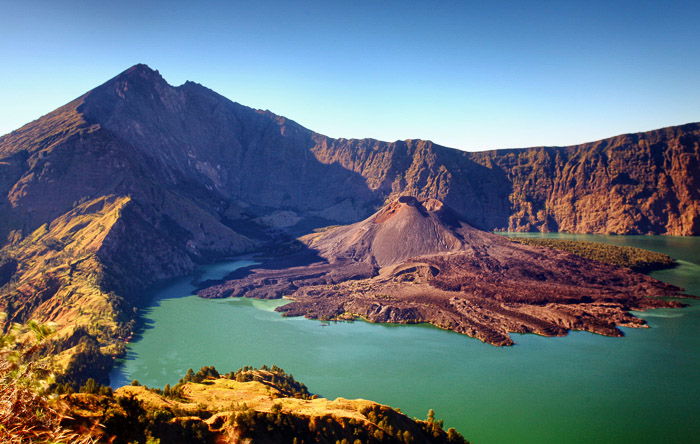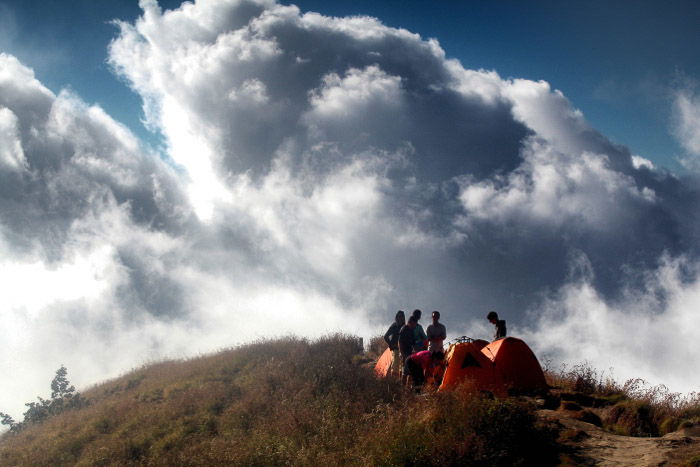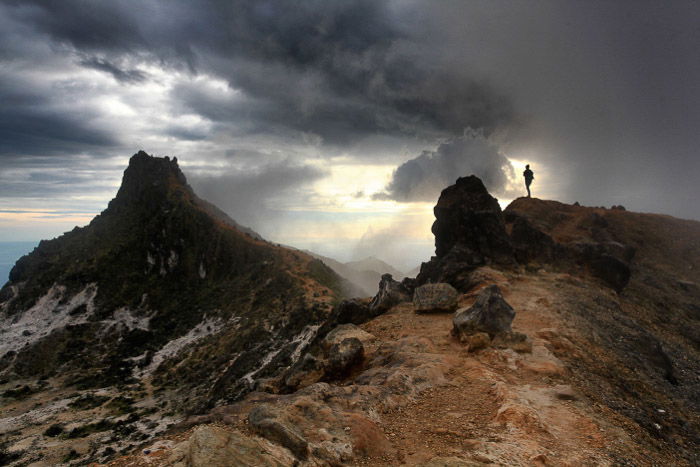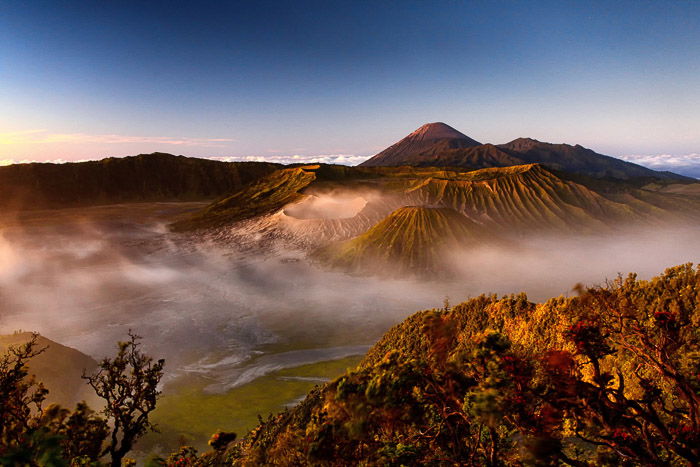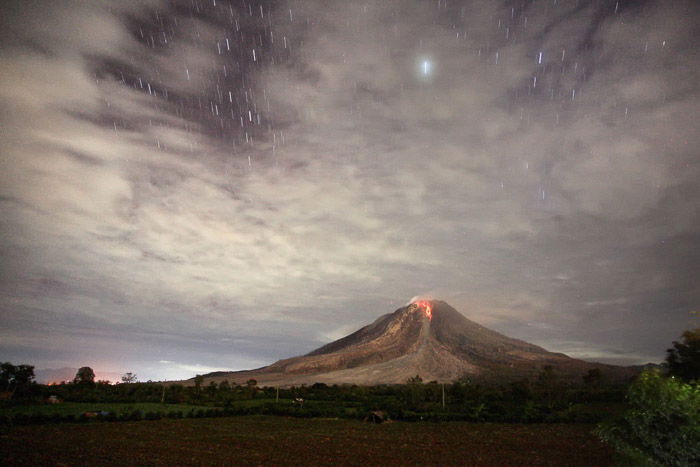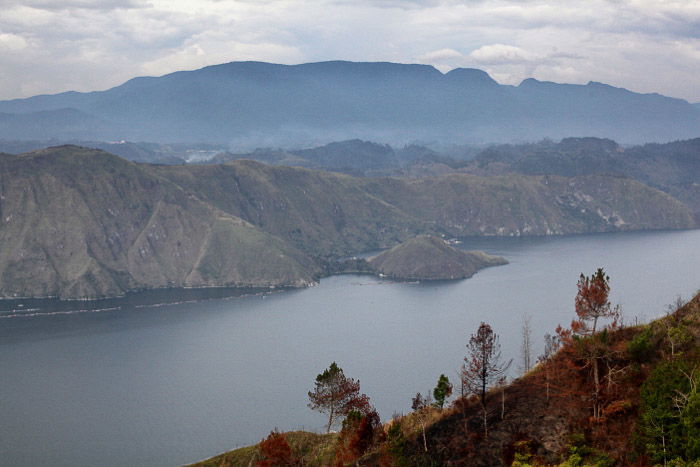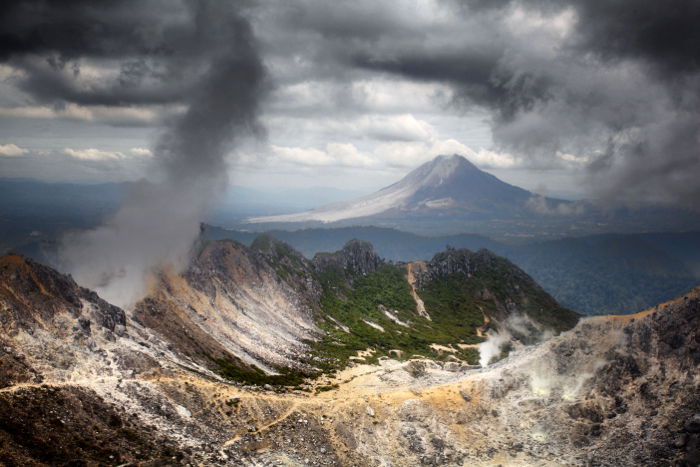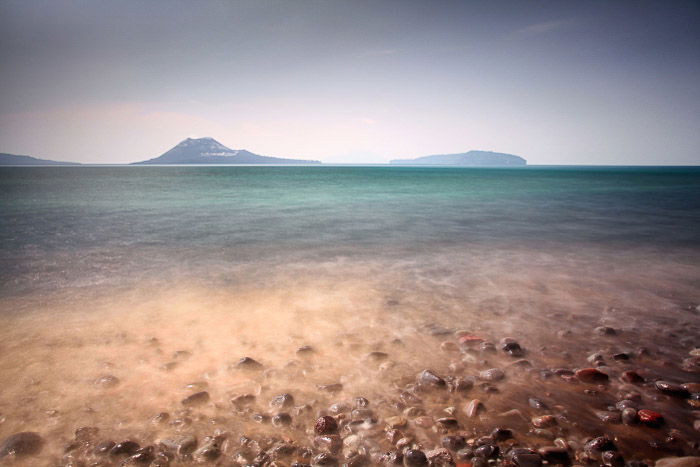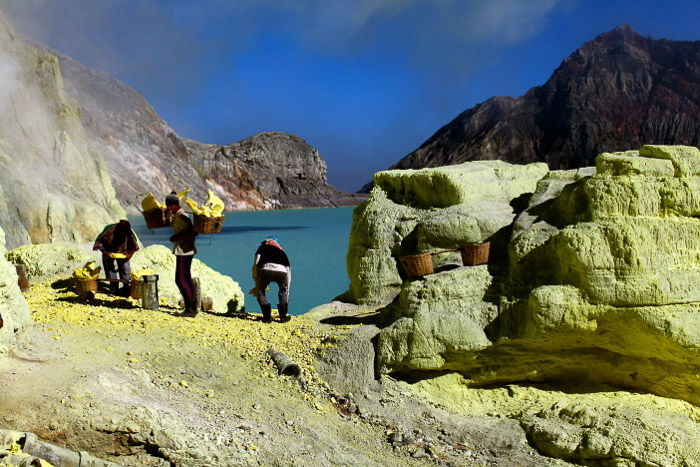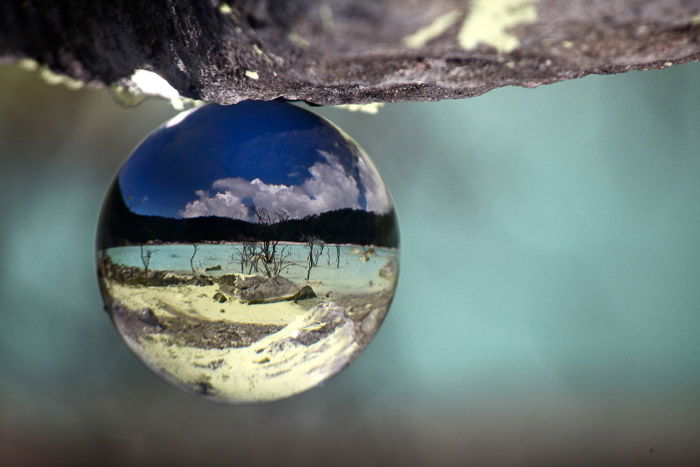[ExpertPhotography is supported by readers. Product links on ExpertPhotography are referral links. If you use one of these and buy something, we make a little bit of money. Need more info? See how it all works here.]
The Best Gear for Volcano Photography
You’ll no doubt have seen the image of a photographer standing on lava, while his tripod and shoes catch fire. The equipment you’ll need for this sort of photography needs to be durable. Let’s divide this list into sections. You’ll need equipment for safety, transit, and for taking the photos.
Safety Gear
Volcanos present a number of hazards. This is especially true if you intend to get close to a volcano or lava flow. There are certain items that should be in every volcano photographer’s kit. You don’t need these if you’re using a telephoto lens to photograph from a distance. Note: None of these things will protect you against a pyroclastic flow.
Helmet – One of the biggest dangers around volcanos is falling rock (or lava bombs). Wearing a helmet will give you some degree of protection from these hazards. Gas mask – There can be life-threatening gases around volcanos. You need a gas mask to protect against this. Heat resistant clothing – Getting close to the lava is risky business. You’ll do so at your own risk. Wearing heat resistant clothing in such an environment is a good idea. You don’t want to catch fire.
Hiking Gear to Get to that Volcano
There are some volcanoes that are in relatively accessible locations. For many of them, you’ll need to traverse extreme terrain to reach them. That means in addition to taking the right safety equipment you’ll also need the following.
Hiking boots – You’ll need a good pair of hiking boots to climb volcanos. Volcanic scree is treacherous to walk on and will tax your energy as well. Warm clothing – Even if you’re climbing volcanos in the tropics, you’ll still need warm clothing. Indonesia sits on the equator. And yet people climbing the volcanos there have been known to die from hypothermia. Walking poles – These will help give extra balance and make it less likely you’ll slip. Rations – As with any serious hiking expedition you’ll need enough food to last you throughout your trip. Water bottle – Enough water for your trip is essential, so bring water bottles and hydration bladders. Consider water purifiers as well if you’re hiking for several days. First aid kit – Plan for the unexpected, and bring a first aid bag with you. Tent and sleeping equipment – You’ll need these if your trip extends over several days. Make sure you’ll be warm if you’re going to a place where the temperature drops a lot at night.
Photography Equipment – Why It’s Last on Our List
Most photographers pack their photography gear first and then see how much space you have left. When photographing volcanoes, you should do the opposite. Pack your photography gear last. And don’t compromise on the safety gear you’ll need. These are the photography items you should take with you.
Camera body – A good solid camera capable of withstanding the extreme environment you’ll be visiting. Dust and weather sealed is a must. Lens – Usually for landscape photography, you’d bring a wide angle lens. This is a good choice for dormant volcanos. For active volcanoes, mid and long focal length lenses are better. Think 24-105 mm or 70-200 mm. Choose your lens before you arrive. Don’t change it, to avoid dust getting onto your sensor. Tripod – This is vital for any landscape photography. This is where bracketing your image will lead to better results. You’ll also need it for any evening and night lava photography you choose to do. Ensure the tripod is sturdy and capable of withstanding heat. Filter – A UV filter will protect the front of your lens. Ash from previous volcanic eruptions can get into the lens. A UV filter will offer protection from various detritus found in volcanic areas. Camera raincoat – The best way to protect your camera is to prevent it from getting dirty in the first place. Adding a layer of protection to it makes sense. Cleaning equipment – Even with all the protection, your camera is still likely to pick up some dust. Clean your camera after use using camera blowers, and cloths.
Where Are the Best Volcanoes to Photograph
Volcanoes are usually found in the tectonically active areas of the world. The aptly named ring of fire is one of these zones. It contains most of the world’s volcanoes. This area takes in New Zealand, Indonesia, the Philippines, Japan, Kamchatka, Alaska, and the western seaboard of North and South America. It’s not the only place where you can find volcanoes though. There are volcanoes in Italy, Iceland, Hawaii, and a couple in Africa as well. If you live near one of these locations you can go local. If you’re looking for a country with many volcanoes then Indonesia is a good place to visit.
Check Your Volcano’s Eruption History Before Visiting
Is the volcano you’re planning to visit currently erupting? When was its last eruption? Does it have a history of small eruptions, and then a colossal one? You’ll want to photograph an actual eruption. Keep an eye on what’s currently erupting, or showing signs of unrest, by following this website.
Why Are Eruption Types Important
Volcano eruptions are divided into a scale known as the volcanic explosivity index or VEI. This scale is divided into eight sections. Those volcanoes like the ones in Hawaii erupt continuously, with lots of lava. The lava is, of course, dangerous, but these volcanoes are not as dangerous as the stratovolcanoes capable of much larger eruptions. Depending on the danger level of the volcano, local authorities may put an exclusion zone around the volcano. It’s worth knowing and respecting this. Volcano eruptions of level 5 and higher are potentially very dangerous, but amazing to photograph. Be aware of pyroclastic flows and lahars. As long as you’re outside the exclusion zone you should be safe.
Ask the Locals for Even More Information
Local knowledge is vital when it comes to photographing volcanoes. You’ll need to find out as much information about the volcano as you can. You should also think about hiring a guide to take you up. You’ll want to find out if the volcano produces dangerous pyroclastic flows. If so, ask in which direction they typically travel.
How to find the Best Vantage Points
You’ll need to spend some time exploring any potential vantage points. Taking a local who knows the best viewpoints for the volcano will speed this process up. You’ll need to see these places yourself to decide whether they’d make good locations to take photos from. You’ll also need to decide on the correct lens to use for each potential vantage point.
Watch the lava and the eruptions
Once you arrive at the site of an erupting volcano you should always spend time watching the eruption from a safe distance. That’s because you need to see the intensity of the eruption, and the direction that lava is traveling in. After doing this, you’ll be able to approach the volcano more closely and find the best places for photography. Approaching a volcanic eruption is very dangerous. It’s not advised that you approach larger eruptions. VEI 2 and lower are the eruptions you can consider getting closer to. The less violent, the better.
Why You Should Plan a Clear Escape Route
Volcano areas are dynamic and unpredictable. Things can change in a split second. Traveling with at least one other photographer or a guide is a good idea. While you’re taking photos, you won’t be completely aware of what’s around you. One person can watch the volcano, in case there is a sudden change of activity, or perhaps a new vent opening. This person can then warn you to escape any impending dangers. Even with all this planning though volcanoes can easily blindside you.
Lava Photography and Photographing Volcanoes
You’ve researched the volcano, you’ve hiked out to it, and done everything you can to ensure your safety. Now you’re finally ready to photograph the volcano itself.
Photographing During the Day
Photographing volcanic eruptions during the day will allow you to capture the more explosive eruptions and their ash clouds. It’s possible to do lava photography as well. Evenings will give you more possibilities for this. The lens you’re likely to be using is a 24-105mm lens. If you’re far away, you may need a longer lens. With daytime photos you can either look to freeze the action, or allow for some motion blur.
Freeze the action – You’ll need a fast shutter speed. You’ll freeze falling lava bombs if you’re close to the volcano, or pyroclastic flows photographed from a distance. Set your shutter speed to 1/1000th, and adjust your aperture and ISO accordingly. The ISO is likely to be 1000 or higher. For landscape photos, you’ll typically want an aperture of f/8. As it gets darker you may need to use a larger aperture. Motion blur – At the other end of the shutter speed spectrum are slower speeds, and the ability to blur motion. You’ll need shutter speeds of 1/20th to capture the suggestion of motion. Try to use this with ash clouds. You can capture lava movement with shutter speeds of 1 second and longer. In order to achieve slower shutter speeds, use an ISO of 100, and a smaller aperture. If needed, add a graduated neutral density filter.
Photographing Volcanoes at Night
One of the best times to practice lava photography is at night. You’ll pick up the distinctive glow of the lava so much better. Photographing during the late blue hour is the best time. You have a better chance of picking up foreground details of the volcano. The later into the blue hour you go, the brighter the lava will appear in the photo. Once it’s fully dark, the rocks will likely be blackout silhouettes against the lava. This is why you should look to photograph during a full moon. Also, take a strong flashlight so you can light paint nearby rocks during the course of the exposure. To capture the lava bomb streaks as they erupt from the volcano look to expose for upwards of 10 seconds.
Post Processing Lava and Volcano Photography
The usual steps you’ll take for regular landscape photography will also apply when photographing volcanoes. Photograph in RAW, and where possible bracket your images. You’ll want to keep your processing subtle. This will ensure your photo is as close to what you see in real life. Photographing in RAW will allow you to deal with lava that’s been overexposed and appears yellow or white in your photo. Reduce the highlights and make sure your lava has a red and orange gradation.
How to Protect Your Gear
In addition to all the precautions already mentioned in this article to protect yourself, you’ll also need to protect the gear you’re using. Burning tripod legs and burning shoes might look amusing in viral photos, but I assure you, they’re not. This is where having someone watching you is a good idea. In the unlikely event you catch on fire, they’ll be on hand to help you put the flames out.
Photographing Dormant Volcanoes
Volcanoes are incredibly beautiful even when they’re not erupting. Features like crater lakes, and harsh geology make them great subjects for photography. Here are some other photography options for when the lava isn’t flowing,
Hiking the volcano – Climbing a volcano while it’s dormant is a worthwhile experience. You’ll still need to deal with volcanic scree, steep ravines, and escaping gas. There are safety hazards even when the volcano sits idle. Geyser – Nature’s natural fountain, these make great main subjects in a photo. Acid lakes – When escaping sulfur gas mixes with a crater lake you’ll get an acid lake. These lakes have an unusual otherworldly feel to them, they’re very photogenic. Sulfur mines – Not as common as they once were, but sulfur can be mined from an active volcano. In Indonesia, this is a practice still carried out by some hardened men, one of the toughest jobs imaginable. This is a strong subject for photojournalism.
Conclusion
Approaching a volcano is always something you do at your own risk. This article only gives advice and doesn’t guarantee your safety. Having said that, photographing volcanoes is a lot of fun, and you’ll come out with some explosive pictures! Have you ever practiced this form of photography? What were your experiences like? We’d love to see examples of the photos you took, so please share your best lava photography!


